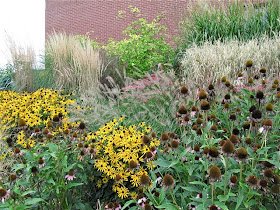 It's been a few years since my fascination with ornamental grasses began. I started out slowly, with a couple of Miscanthus varieties, then a Hakonechloa, then a Calamagrostis. It takes grasses at least three years to develop some size, and the warm-season grasses seem slow to establish and late to bloom here in my garden. But they are so worth it. The foliage, the flowerheads, the way the light glistens on leaf blades and flowers, the song of the grasses as the wind wafts through them...they're just all around delightful.
It's been a few years since my fascination with ornamental grasses began. I started out slowly, with a couple of Miscanthus varieties, then a Hakonechloa, then a Calamagrostis. It takes grasses at least three years to develop some size, and the warm-season grasses seem slow to establish and late to bloom here in my garden. But they are so worth it. The foliage, the flowerheads, the way the light glistens on leaf blades and flowers, the song of the grasses as the wind wafts through them...they're just all around delightful. There are a few caveats when purchasing grasses.
There are a few caveats when purchasing grasses.  The feather reed grasses (Calamagrostis cultivars such as 'Karl Foerster', 'Overdam' and 'Avalanche') bloomed in July, but their tawny golden seedheads are still holding on nicely in my garden. I do find their stems are a little more apt to break down in the wind than are those of other grasses, but I love them anyway.
The feather reed grasses (Calamagrostis cultivars such as 'Karl Foerster', 'Overdam' and 'Avalanche') bloomed in July, but their tawny golden seedheads are still holding on nicely in my garden. I do find their stems are a little more apt to break down in the wind than are those of other grasses, but I love them anyway. On Friday, I was in Truro at the Nova Scotia Agricultural College, and my friend Carol took me down to the Haley Institute at the farm part of the campus, to show me the grass garden that she and her students planted a few years ago. It's at its best now, with sedums, pussytoes, asters and coneflowers mixed among the cascades and fountains of perennial grasses.
On Friday, I was in Truro at the Nova Scotia Agricultural College, and my friend Carol took me down to the Haley Institute at the farm part of the campus, to show me the grass garden that she and her students planted a few years ago. It's at its best now, with sedums, pussytoes, asters and coneflowers mixed among the cascades and fountains of perennial grasses. Some people like to do their grasses in display beds of grass only. While I like those, I get impatient earlier in the season when the grasses are just growing and not blooming, so I prefer to incorporate perennials and shrubs with my grasses, as the garden at NSAC is done.
Some people like to do their grasses in display beds of grass only. While I like those, I get impatient earlier in the season when the grasses are just growing and not blooming, so I prefer to incorporate perennials and shrubs with my grasses, as the garden at NSAC is done. Doesn't this look a lot better than just boring old lawn? Low care, drought tolerant, effective at holding the sloped area in place, and awash with life--birds, bees, other pollinators flitting around the flowers and seedheads.
Doesn't this look a lot better than just boring old lawn? Low care, drought tolerant, effective at holding the sloped area in place, and awash with life--birds, bees, other pollinators flitting around the flowers and seedheads. I love panic grasses, also known as switchgrasses. Their flowerheads are delicate, with tiny individual flowers, and they're subtle--you need to slow down, stop and look at them to appreciate them. Many have gorgeous coloured foliage, some with red or burgundy tips such as 'Shenandoah' or 'Cheyenne Sky'; others are bluer in foliage, such as 'Dallas Blues' and 'Thunderhead'.
I love panic grasses, also known as switchgrasses. Their flowerheads are delicate, with tiny individual flowers, and they're subtle--you need to slow down, stop and look at them to appreciate them. Many have gorgeous coloured foliage, some with red or burgundy tips such as 'Shenandoah' or 'Cheyenne Sky'; others are bluer in foliage, such as 'Dallas Blues' and 'Thunderhead'.
Definitely showier in nature, and eyecatchingly fabulous throughout fall and winter, are the miscanthus species and cultivars also known as silvergrasses and maidengrasses. These later blooming varieties stand tall in a garden, and sound like waves of water when the wind rustles them. Some of them have remarkable fall colour, including purple flame grass, M. 'Purpurascens'. Some have wonderful gold striations in their foliage, such as 'Strictus', 'Gold Bar', and 'Little Kitten.'. They're just great plants.
 The best way to get to know and appreciate grasses is to look for display gardens featuring them, such as those at many nurseries. This garden is at Bunchberry in Upper Clements, and features a rich selection of grasses, from the low clumps of Carex 'Ice Dance' to the tall, elegant sprays of moor grass, Molinia 'Skyracer'. Many municipalities are using grasses in their public plantings, businesses are embracing them for their landscapes...what are YOU waiting for?
The best way to get to know and appreciate grasses is to look for display gardens featuring them, such as those at many nurseries. This garden is at Bunchberry in Upper Clements, and features a rich selection of grasses, from the low clumps of Carex 'Ice Dance' to the tall, elegant sprays of moor grass, Molinia 'Skyracer'. Many municipalities are using grasses in their public plantings, businesses are embracing them for their landscapes...what are YOU waiting for? 







































